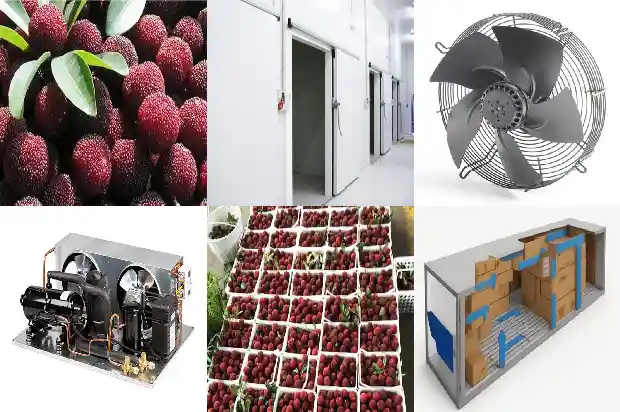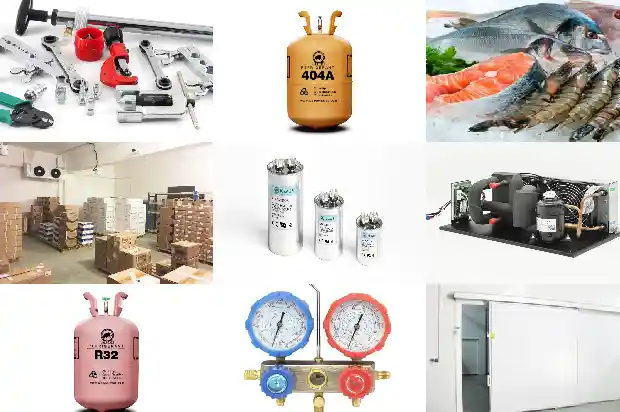Structure and Common Faults of Hermetic Compressors
2025-03-17
Hermetic compressors, featuring a compact structure, light weight, and low noise, are mostly utilized in small - sized refrigeration units. The structure of a hermetic compressor consists of a welded - sealed casing. Inside, the compressor and the motor share a main shaft, and the unit structure is suspended by springs within a casing formed by stamping steel plates.

Based on the structural characteristics, hermetic compressors can be classified into reciprocating piston compressors and rotary compressors. Reciprocating piston compressors can be further divided into connecting - rod type, slider - tube type, and electromagnetic type. Rotary compressors include fixed - vane type, rotating - vane type, and scroll type.
How can one determine if a hermetic compressor has malfunctioned? Generally, the first step is to judge according to the abnormal sound after startup, and the second is to check if there are oil traces around the terminal posts. Common malfunctions of hermetic compressors are as follows:
(1) The compressor fails to start. Reasons:
a) Whether the compressor is overloaded, and whether the pressure switch and over - current protector have tripped or are damaged.
b) Whether the indoor temperature sensor and pipe temperature sensor are open - circuit, have poor contact, or are short - circuited.
c) Check whether the relay is engaged, whether the compressor is open - circuit or short - circuited, and whether the compressor capacitor is defective.
a) Whether the compressor is overloaded, and whether the pressure switch and over - current protector have tripped or are damaged.
b) Whether the indoor temperature sensor and pipe temperature sensor are open - circuit, have poor contact, or are short - circuited.
c) Check whether the relay is engaged, whether the compressor is open - circuit or short - circuited, and whether the compressor capacitor is defective.
(2) The compressor emits a "thud - thud" knocking sound.
a) The suspension spring has poor quality and breaks.
b) The suspension spring is not properly assembled and detaches.

a) The suspension spring has poor quality and breaks.
b) The suspension spring is not properly assembled and detaches.
(3) The efficiency of the compressor declines. Reasons:
a) The moving parts are worn, causing an excessive clearance in the fit.
b) The suction and discharge valve plates are broken or do not close tightly.
c) The cylinder gasket asbestos board is punctured.
a) The moving parts are worn, causing an excessive clearance in the fit.
b) The suction and discharge valve plates are broken or do not close tightly.
c) The cylinder gasket asbestos board is punctured.
(4) Oil seeps from the terminal posts of the compressor or other welded parts. Reasons:
a) The terminal posts are poorly welded or the glass insulators are broken.
b) The casing or the outlet pipes have weak welds.
a) The terminal posts are poorly welded or the glass insulators are broken.
b) The casing or the outlet pipes have weak welds.
(5) The compressor runs but does not refrigerate, or there is a "hissing" sound from the casing. Reasons:
a) The refrigerant is over - filled.
b) The high - pressure pipe is broken, and the high - and low - pressure valve plates are shattered.
a) The refrigerant is over - filled.
b) The high - pressure pipe is broken, and the high - and low - pressure valve plates are shattered.
(6) The compressor motor emits a "keng - keng" sound during operation. Reason:
Generally, it is caused by a severe three - phase imbalance. One - phase of the power supply is missing. Restoring the three - phase power supply can resolve the issue.
Generally, it is caused by a severe three - phase imbalance. One - phase of the power supply is missing. Restoring the three - phase power supply can resolve the issue.
(7) Inspection for a completely non - functioning compressor. After removing the compressor, it can be tested by applying power. Use the method of checking the air flow at the exhaust port or the suction port: Block the high - pressure exhaust port or the low - pressure suction port. If there is a strong air flow, it indicates that the compressor is normal. If there is a very weak air flow at the high - pressure exhaust, or even no air flow, it means that the high - pressure cylinder head gasket or paper gasket is punctured, or the valve plate is shattered. If there is a weak exhaust, it indicates that the compressor has low efficiency. If there is no exhaust, but a hissing sound can be heard, and the sound disappears after shutdown, it means that the connection between the high - pressure buffer pipe and the casing, or the gas outlet cap is broken, or the gasket is cracked. Replace the compressor or send it to the manufacturer for repair.
Related Articles
- Forms and Structures of Oil Separators in the Refrigeration System
- Differences Between Steel Structure Cold Storages and Multi-story Civil Engineering Cold Storages
- The Structure and Components of Centrifugal Compressors
- What are the characteristics of the structure of small cold storage?
- Common Faults and Solutions in Cold Storage Maintenance
- Common Faults and Treatment Methods of Single-phase Asynchronous Motors
- Common Faults and Daily Maintenance of Commercial Ice Makers
- Analysis of Common Faults of Chillers
- Wiring Methods, Faults and Classifications of Fan Coil Units, All Here~~
- Eliminate the "Blockage" Faults (Ice Blockage, Dirt Blockage, Oil Blockage) of the Refrigeration System in 5 Minutes
- How to Inspect and Troubleshoot the Faults of the Control Valve in the Cold Storage?
- Common Faults in Refrigeration Systems and Handling Methods
- What Are the Common Causes of High - pressure Faults in Chillers?
- Basic Faults and Preventive Maintenance of Water - cooled Units
- Composition and Common Faults of Screw Refrigeration Compressors
- Common Faults and Solutions of Central Air - conditioning Chiller Units
- Common Faults of Industrial Chillers
- Common Faults and Corresponding Solutions of Chillers During Use
